Angela Slatter's Blog, page 58
June 22, 2016
South Perth Library
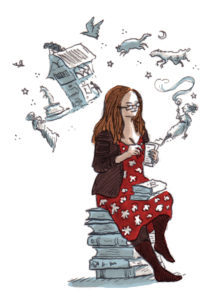 So, if you’re in Perth and can’t get out to any of the things I’m doing at KSP, I’ll also be at the South Perth Library for a Words with Wine event.
So, if you’re in Perth and can’t get out to any of the things I’m doing at KSP, I’ll also be at the South Perth Library for a Words with Wine event.
Fairy stories are part of childhood – who doesn’t remember their favourite; Cinderella, Little Red Riding Hood, Puss in Boots or the Ugly Duckling? But how does one go on from childish delight in princesses, castles, trolls and magic to write award winning fairy stories for adults, re-work the old tales, and end up writing dark urban fantasy set in Brisbane (of all places!)?
Come and enjoy a glass of wine while Angela Slatter explains how this journey unfolded for her. Angela will also read from her works, answer questions and sign books.
Books sales available on the the night thanks to Stefen’s Bookshop.
For booking details, go here.
June 21, 2016
Alex Caine Lives Again: Alan Baxter
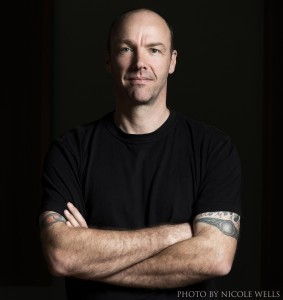 Yes! The Alex Caine series is so good and kickass that it got a second release! Bound, Obsidian, and Abduction are all now in paperback format as well as ebookery.
Yes! The Alex Caine series is so good and kickass that it got a second release! Bound, Obsidian, and Abduction are all now in paperback format as well as ebookery.
Alan Baxter is a British-Australian author who writes dark fantasy, horror and sci-fi, rides a motorcycle and loves his dog. He also teaches Kung Fu. He lives among dairy paddocks on the beautiful south coast of NSW, Australia, with his wife, son, dog and cat. He’s the award-winning author of several novels and over sixty short stories and novellas. So far. Read extracts from his novels, a novella and short stories at his website – www.warriorscribe.com – or find him on Twitter @AlanBaxter and Facebook, and feel free to tell him what you think. About anything.
1. What do readers need to know about Alan Baxter?
I’m a writer of speculative fiction, mostly dark weird fantastical stuff, with lashings of horror and occasional forays into science-fiction. I tend to genre-blur a lot and mix in elements of crime, noir, thriller, mystery and so on with my dark weird. I’m also a martial arts instructor, and run the Illawarra Kung Fu Academy as my “day job”. I listen to heavy metal, ride a motorcycle, have a dog who’s a complete numpty and a son who’s a delightful terror. Thankfully my wife helps out with that, and with the Kung Fu, as she’s my deputy instructor there and a master in her own right.
2. Who were/are your literary heroes/influences? 
So very many! Clive Barker, H P Lovecraft, Ursula Le Guin, Alan Moore, Garth Ennis, Shirley Jackson, Neil Gaiman, Douglas Adams, Anne McCaffrey… you know what? I could just go on all day doing this. Let’s just say that everything I write is supported on the shoulders of countless giants who wrote before me and many who continue to write now.
3. What was the inspiration for the Alex Caine Series, and will we see more of Alex and Silhouette?
As a martial artist and writer I developed a reputation for writing good fight scenes, so I decided to write a book where the protagonist was an actual career martial artist. Alex Caine is a very successful underground MMA cage fighter. I also had this plot idea knocking around that meant taking the old-fashioned fantasy quest trope and putting it into a modern, dark/horror kind of setting. When I slammed those two things together, Alex Caine 1: Bound was born. While writing it, I realised the story was much bigger and while each novel of the trilogy is a standalone story, there’s a major arc that goes over all three books and is resolved at the end of Abduction.
However, I deliberately let a number of smaller threads hang loose and there are all kinds of opportunities for more books in the Alex Caine Series. I’ve made notes, in fact, so with any luck this trilogy will sell well and I’ll get to write more. I’ve also got a few ideas for some standalone Silhouette stories, probably novella length, so that would be fun too.
4. Name five fictional characters you’d like to meet in the ring.
All-in six person brawl? I like your thinking! Or did you mean one at a time? Anyway, some of the greatest fighters and brawlers from fiction would include Batman and Talia al Ghul – they would both test my skills to the max. Jack Reacher, because I could totally take out that guy and I reckon he’d be up for a scrap. Pinhead, because he’s delivered so much pain, I think it’s time he had some back. (Yeah, I know he has a headful of nails a life of pain, shut up.) Sun Wukong, the Monkey King, from Journey to the West. To be honest, I always wanted to be him, so getting to scrap with him would be aces and the next best thing. We could fight barehanded first, then have a battle using staffs. And Edward Cullen, because if anyone deserves a right bloody kicking…
 5. What would you say you learned from writing your early books?
5. What would you say you learned from writing your early books?
Brevity. I learned how to build a compelling narrative, how to keep the pace up and the pages turning, but both RealmShift and MageSign are around 120,000 words where with The Alex Caine Series each book is around 100,000. I think my improving skills in short fiction contributed to that too. I also learned that it’s bloody hard work and you simply have to sit your arse in the chair and get to work if you want to see anything finished.
6. What’s your favourite short story ever and why?
Nope. Impossible question. I’m not sure I can ever really name one single story, but across the volumes of Clive Barker’s collections, The Books of Blood, are so many favourite stories. Also stuff by Margo Lanagan and Kaaron Warren just blows my mind. I think Stephen King is better at short fiction than novels, but that’s a bit of a controversial opinion. Shirley Jackson’s stories are amazing, as are Edgar Allen Poe’s. And, more contemporary again, I’ve recently talked a lot about Nathan Ballingrud’s collection, North American Lake Monsters, and Laird Barron’s collection, The Beautiful Thing That Awaits Us All, because both are absolutely superb! Look at how cleverly I avoided that awful question of choosing one favourite by listing heaps of reading. I could go on and list loads more too. I can never pick a favourite.
7. When you’re in the mood to read, who is your first choice?
It really depends on the mood. For example, Clive Barker (again!) is always a go-to author for compelling darkness and twisted fantasy. If I want something with precision-sharp prose and heart I’ll go to Ursula Le Guinn. Stephen King for amazing characters. But more often than that, I’m always in the mood to read and I love to discover new and powerful voices. I’ve got into the habit recently of reading one old classic then one newer, more contemporary book. For example, I recently read Peter Straub’s Ghost Story (which is amazing!) and now I’m reading Neal Stephenson’s Seveneves.
8. What was the story/book that made you think ‘I want to write!’?
I’m not sure there was one enlightening moment like that. I can only remember always reading and always writing. I’m sounding like such a fanboy now, and that’s because I am one, but I do remember the first time I read Barker’s The Great and Secret Show I thought, “I want to write like that!” But then, the same thing happened with McCaffrey’s Pern books and Gaiman’s Sandman Cycle and… and… and…
9. Who is your favourite fictional villain and/or hero? 
Batman and The Joker. No question. I think they’re each among the best fictional characters ever and combined they’re perfect. They can’t exist without each other. Batman is a desperate force for unattainable order while The Joker is the embodiment of absolute chaos. Because The Joker has no agenda beyond chaos, that makes him genuinely the scariest bastard ever. And of course, Batman appeals to me as the superhero without super powers, just endless hours of physical training, detective skills and mad cool tech. I’d quite like his family fortune too…
10. What’s next for Alan Baxter?
Well, all three books in The Alex Caine Series are out in paperback right about now (June 20th they hit book store shelves), so that’s my primary focus. Then my first collection of short fiction, Crow Shine, is coming from Ticonderoga Publications in September, and I’ll be Guest of Honour at Conflux at the start of October, which is very exciting. The Alex Caine Series starts its international life with Bound being published by Ragnarok Publications in December (with Obsidian and Abduction both out together in July 2017) so for everyone outside Australia and New Zealand, look out for that! I’ve got a standalone monster thriller novel called Primordial that I co-wrote with David Wood being published internationally by Cohesion Press in January. I’ve also got a mystery/police procedural/cosmic horror novella coming out soon – can’t say more at the moment, but can hopefully talk about it before long – and a new standalone noir/cosmic horror novel is out with my agent now, so that will hopefully find a home before too long as well. And on top of that, I’ve got a new standalone horror novel out with beta readers right now, and I’m working on another collaborative novel with David Wood, an action adventure thriller with occult trappings. And I’ve just started work on a new standalone crime noir novel with supernatural leanings. Bloody hell, when you make me write it all down like that it seems like quite a lot. No wonder I’m tired!
June 20, 2016
June 15, 2016
Over in the Hachette Australia Office …
 … shiny shenanigans are afoot!
… shiny shenanigans are afoot!
The really real Vigil is in da house!
I may well have been doing some next level flailing on the bus as I watched that.
June 14, 2016
Envy of Angels: Matt Wallace
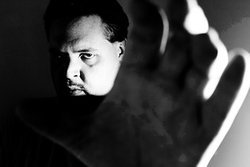 Writemeister, Mr Matt Wallace, is the envy of everyone with his Sin du Jour series for Tor.com. All you really need to know is that his writing is freaking hilarious, he’s also a screenwriter, and he once taught Tai Chi to senior citizens.
Writemeister, Mr Matt Wallace, is the envy of everyone with his Sin du Jour series for Tor.com. All you really need to know is that his writing is freaking hilarious, he’s also a screenwriter, and he once taught Tai Chi to senior citizens.
1. First of all, what do new readers need to know about Matt Wallace?
I used to be an asshole, but I’m better now. Mostly.
2. Where did the original idea for Envy of Angels (and by extension the Sin Du Jour series) come from?
I remember the first time I talked about it out loud was when I pitched it to my fiancée, Nikki, in the car on our way to Las Vegas. I pitch her all my ideas first. She’s my best and harshest critic, and if I can convince/sell her, I know I can sell anybody. I wanted to write something more contemporary and commercial, which I know sounds ghastly to everyone who has never struggled to make a living as a writer. I’m an avid home cook, foodie, and I spent a lot of time around high-end kitchens when I lived in NYC. Somehow all of that came together to form the germ of an idea about who precisely does the cooking in urban fantasy-type stories for all these fantastical creatures.
3. Your top five novels are …? 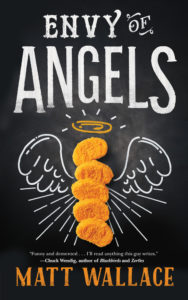
DUNE will always be a favorite, despite the fact not all of it has aged well for me. But when you’ve studied and taught knife work for as long as I have, a novel in which the entire political, economic, and ecological fate of the universe is resolved via knife fight will always hold water. Ken Grimwood’s REPLAY, Christa Faust’s HOODTOWN, William Goldman’s HEAT, and Stephen King’s THE RUNNING MAN are all all-time favorites I’ve probably read the most.
4. When did you first start writing and can you remember the first thing you finished?
I started making up stories before I could write. I’d illustrate them and my mother would write the words down for me. I think she still has the first one. It sucked. I’m still a lousy artist, too. The first full-fledged story I can remember finishing was one I wrote for Knott’s Berry Farm’s Ghosts of the Old West Short Story Contest for elementary school kids. It was about two whisky peddling brothers in bowler hats taking their wagon across the country and meeting all manner of figures from western American history and folklore. I won the contest, btw.
5. Who were/are your literary heroes/influences?
When I was a teenager I wanted to be as clever with words as Douglas Adams and as striking with metaphor and simile as Poppy Z. Brite.
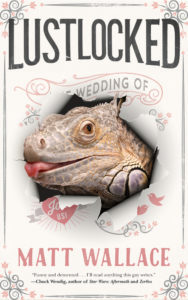 6. Which do you prefer: writing the first draft or doing the editing afterwards to make it shiny?
6. Which do you prefer: writing the first draft or doing the editing afterwards to make it shiny?
YOU’RE ALLOWED TO MAKE CHANGES AFTER YOU WRITE IT THE FIRST TIME? WHY DIDN’T ANYONE TELL ME?
7. When you’re in the mood to read, who is your first choice?
These days I tend to grab the books I’ve read a million times, because I’m just really damn busy. Silvia Moreno-Garcia, Madeline Ashby, Alyssa Wong, and Kameron Hurley are some of the newer authors I’m excited to read lately when I can find the time
8. Which book, either fictional or otherwise, would you say taught you the most about writing?
The first novel I wrote. It was terrible. It taught me what not to do and what kinda/sorta worked. I think that’s the book that teaches every writer the most about writing. Their first, or their first through their fifth. It depends.
9. You invite five fictional characters for dinner and shenanigans: who makes the guest list?
Four of the Beagle Boys and Scrooge McDuck, at which point I break a pool cue, drop both halves on the floor, turn off the lights and lock the door behind me.
10. What’s next for Matt Wallace? 
More books! My next Sin du Jour novella, PRIDE’S SPELL, comes out on June 21st in print and as an ebook from Tor.com Publishing, and we’ll be doing four more Sin du Jour books after that throughout 2017 and 2018. I’m also finishing my first epic fantasy novel. In-between all of that I am writing for the moving pictures, with an emphasis on the small screen, and will hopefully have more to talk about there soon.
June 13, 2016
Reminder: Vigil giveaway
 Tomorrow is the last day, Oz readers, to enter the Goodreads giveaway of Vigil.
Tomorrow is the last day, Oz readers, to enter the Goodreads giveaway of Vigil.
Just saying.
Like, here.
PS: When I’ve got my author copies, America, I’ll do a giveaway just for you!
June 8, 2016
Vigil Launch is go, go, go!!
 Okay! The Brisbane City Library now has the Vigil launch on their calendar. It’s a free event, but you do need to call and book to attend (yes, even those of you who are related to me). And, go!
Okay! The Brisbane City Library now has the Vigil launch on their calendar. It’s a free event, but you do need to call and book to attend (yes, even those of you who are related to me). And, go!
Or, for those of you like me who like their clickery more obvious, click here for details.
June 7, 2016
The Assimilated Cuban’s Guide to Quantum Santeria: Carlos Hernandez
 The best way to introduce Carlos Hernandez is to steal (with love, grace, and credit) from Haralambi Markov’s review of his short story collection over at Tor.com.
The best way to introduce Carlos Hernandez is to steal (with love, grace, and credit) from Haralambi Markov’s review of his short story collection over at Tor.com.
The Assimilated Cuban’s Guide to Quantum Santeria comes out of nowhere, blindsides you with its witty play on language, and steers you into a realm of delightful science fiction which blurs present and future with fingers steady on the pulse of modern culture as it is now. Carlos Hernandez, in this one collection, has managed to convince me he belongs in my heart as a favorite. He has shown me how to boldly contort structure in short fiction without taking any hostages and in the instances he succeeds, the payoff is significant and rewarding, leaving the reader a beast contented after a feast.
Or for something a little more official, Rosarium’s author’s bio: Carlos Hernandez is the author of over 30 works of fiction, poetry, prose and drama. By day, he is an Associate Professor at the City University of New York, where he teaches English courses at BMCC and is a member of the doctoral faculty at The CUNY Graduate Center. Carlos is also a game designer, currently serving as lead writer on Meriwether, a CRPG about the Lewis and Clark Expedition. He lives in Queens, which is most famous for not being Brooklyn.
If that does not convince you, then you are simply obdurate and I’ll have nothing further to do with you.
1. What do readers need to know about Carlos Hernandez?
I am constitutionally built for optimism. I like to make friends, laugh with strangers, invite people to play. I’m no Pollyanna, I promise! I have a pretty nihilistic worldview in the macroscope. But in the day-to-day, I am awash in people who want to do right, who show mercy and give generously, who try to do their duty even in the face of a merry-go-sorry life that redefines duty even as it’s being carried out. These are the people who deserve laughter and knotty thought experiments to ponder and VIP access into the magic circle that is another person’s imagination. I love to write for this audience.
More practically, I write, I teach college, I play games and I make them.
2. Can you remember the first story you read that made you think “I want to write!”?
I had a bilingual edition of Ferdinand the Bull when I was a wee Carlito. Read it until it became sweaty confetti in my hands. I now own a translation of that story—in Latin.
3. What was the inspiration for The Assimilated Cuban’s Guide to Quantum Santeria?
The collection is 12 stories! Each had its own inspiration!
“The Aphotic Ghost”: Werewolves? Bah! Where are the were-jellyfish stories?
“Homeostasis”: We already have zero idea whether anyone else exists. I will prove it once and for all. Also: faith feels nice.
“Entanglements”: If the Many Worlds Theory is correct, there are an infinite number of yous who are better at life than you are.
“The International Studbook of the Giant Panda”: There is literally a book in the world called The International Studbook of the Giant Panda that documents every known sexual encounter between pandas tagged and in captivity. Really, if you need any more inspiration than that, don’t be a writer.
“The Macrobe Conservation Project”: No one’s going to believe this, but the direct inspiration for this story was Junot Díaz’s collection Drown. Yunior on a space station dealing with Dad.
“Los Simpáticos”: a legend Mami told me about women using the hydrogen cyanide in tropical stone fruit to induce abortions led me to imagine a reality T.V. show in which people hire fake hitmen and then are interviewed by a reporter as to why.
“More Than Pigs and Rosaries Can Give”: Conducting research into the Cuban Revolution disabused me of simplistic notions of The Left (though, full disclosure, I remain quite Left) and of politics in general. So I wrote a story in which a Cuban spiritualist sucks ghosts out of the bullet holes left in the walls where they were executed by firing squad.
“Bone of My Bone”: Cuckolding is such bullshit: your partner cheats on you, and so you grow horns? Not on my watch.
“The Magical Properties of Unicorn Ivory”: I hate how animals are slaughtered for ivory. I also don’t always think it’s wrong to lie to children.
“American Moat”: The problem with patrolling the U.S./Mexico to keep aliens out of America is that some aliens have stuff you want. Like superpowers.
“Fantaisie Impromptu #4 in C#min, Op. 66”: Catholics aren’t looking forward to The Singularity nearly as much as the rest of us. Here’s why.
“The Assimilated Cuban’s Guide to Quantum Santeria”: What any Latinx can tell you: magical realism is actually realism. More or less creative nonfiction.
4. Which is your favourite Assimilated Cuban story and why? 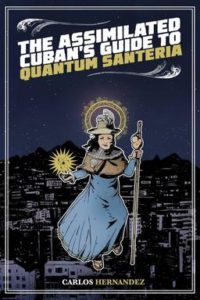
You can’t pick favorites among your children! Well, of course you can. You just don’t do it out loud.
What I’d say to readers is that:
if you take your sarcasm black with lots of sugar, read “Los Simpáticos,” “Bone of My Bone,” and “American Moat.”
if you like Big SF Ideas, you might enjoy “The Aphotic Ghost,” “Homeostasis,” “The Macrobe Conservation Project,” and “”
if you want a more “novelly”-type reading experience, a lot of readers really seem to like my recurring narrator Gabby Reál, a reporter on the fringes of science and magic; the three stories that feature her are “The International Studbook of the Giant Panda,” “The Magical Properties of Unicorn Ivory,” and “Fantaisie Impromptu #4 in C#min, Op. 66.”
if your tastes run more toward fantasy, magical realism, and questions of cultural ethnicity, try “More Than Pigs and Rosaries Can Give” and “The Assimilated Cuban’s Guide to Quantum Santeria.” (“Entanglements” also fits here.)
This is a mighty, mighty cop-out on my part. I am totally okay with that.
5. You get to invite five fictional characters to dinner ? who do you choose and why?
Gargantua—because he suggests the very best way to wipe one’s butt is to use the neck of a goose. Can’t wait to see what he comes up with next.
Oly Binewski (from Geek Love)—This book gave me the same “oh you can do this shit in literature?” epiphany that Gárcia Márquez had when reading Kafka, and Oly’s the narrator who payed out that revelation, metaphor by lightning-strike metaphor. I would love to say “thank you” in person and give her a hearty, soul-comforting stew to eat.
Ivan Karamazov, because boy is he beautiful and boy is he broken. We’ll perhaps avoid the topic of religion. (I’ve limited myself to one choice from Brothers K. here, because I could imagine a separate party where it was just the whole cast from the novel. Would lock the liquor cabinet up tight, though.)
The Wife of Bath—Feminist before it was cool! Hilarious, knows how to tell a story, and might be able to talk some sense into Ivan.
The Pied Piper, as represented by C. S. E. Cooney in her Nebula-nominated novella “The Bone Swans of Amandale.” That story broke me. Beauty is terrible and hurtful and may I have another? That’s her Pied Piper in a sentence.
6. Who were/are your literary heroes/influences?
Going to stick to the mostly dead or apotheosized-whilst-alive here. And I’m guessing everyone tells you the same thing: “too many to mention!” etc.
That said: Dostoyevsky. Flannery O’Connor. Alice Munro. Piers Anthony (as a young man). Katherine Dunn (for one book, but what a book!). John Barth, Asimov, Gárcia Márquez, William Gibson, Laurence Sterne, Kathy Acker. Rabelais!!!
Oh God oh God. Too many to mention. Bradbury, Heinlein (yes, I know, but shut up), C.L. Moore (“Shambleau”!), metric tons of delicious Pulp, OCTAVIA BUTLER. Please, denizens of sky and underworld, let me once write something a third as artistically complete as Kindred.
Frankenstein. Wallace Stevens. The Satanic Verses. Who has ever written better sentences than Elizabeth Bishop? Raymond Carver, especially the stories in Cathedral.
Don Quixote is required reading! And as soon as you’re done, read Pedro Juan Guiterrez’s Dirty Havana Trilogy—a book more profound than profane, and holy shit is it profane—and you’ll understand my sense of humor completely.
Bless me, Ultima: please read this right now if you haven’t read it, and if you have read it, it’s been too long and you should reread it. Everyone should take a semester to study James Baldwin and another to study Toni Morrison. And Gogol. Minor in Gogol!
Too many. I have a Ph.D. in English mostly to have an excuse to read for six years. I love so many books. I am reading genre works these days mostly by living authors and can tell you I truly believe we’re living through an SFF Renaissance. Going to stop now.
Wait, not yet! Isabel Allende! Wang in Love and Bondage. Emily Dickinson. The Master and Margarita!
7. How did you link up with Rosarium Publishing?
Bill Campbell, Rosarium’s soul, asked me if I would contribute a story to the press’s anthology Mothership. Of course I would! And then he asked if I had a manuscript. I hadn’t been thinking about a collection of stories previously, but I can tell you truly, I had a pitch ready before I had finished reading that sentence he wrote me!
 8. Which book, either fictional or otherwise, would you say taught you the most about writing?
8. Which book, either fictional or otherwise, would you say taught you the most about writing?
The most honest answer I could give is “whatever the last book I read is,” because that is one fundamental reason writers read. But though true, I know that sounds glib. I’ve also expressed a lot of this answer above, so let me add something new to the interview by saying this: the unpublished, unindited book of Mami’s stories and Papi’s wrecking-ball décimas served as my introduction to the creation of an ontology via the medium of language. Actually, two languages, Spanish and English.
9. The future of the short story is …?
… shitty, in terms of payment; spectacular, in terms of quality of the work being published in SFF; meh, in terms of the so-called “literary” short story; meh again in terms of readership. One of the things that has always confused me about modern life is that people are busier than ever, and electronic formats are constantly reducing the number of words we get to read online. Yet it’s novels that sell. Why u no like short stories, readers? Dunno.
10. What’s next for Carlos Hernandez?
Two big projects:
My novel, Planet Havana, imagines a world where the U.S. invades Cuba and finally restores it to its “destined” role as American playground for the rich or credit-worthy. The Cuban Communist hardliners that remain shoot what’s left of the Cuban Revolution up into space and invade an orbiting theme park, which they rename Planet Havana. This incenses the well-heeled paramilitary social club Granma Nueva (made up of Cubans who will never let go of their hatred of Communism) to clone Fidel Castro, but train the clone to be a neoliberal capitalist. It’s this clone-Castro’s mission to become Planet Havana’s new dictator and destroy the Cuban Revolution once and for all. On the fourth draft now, and maybe a few months more?
The video game on which I’ve served as a designer and the lead writer—Meriwether—is going gold very very soon! It’s a 1st-Person CRPG where you play as Meriwether Lewis and try to guide the Lewis and Clark expedition across North America and back to St. Louis, making as many allies of the First People nations as you can and filling your journals with as many descriptions of the flora and fauna new to Western science as possible. Think Oregon Trail with A. Noire-style dialogue and historical rigor like you’ve probably never seen in a video game.
May 31, 2016
And over at Ventureadlaxre …
 … Vigil scores some big love! The highlights:
… Vigil scores some big love! The highlights:
(tl;dr version is I LOVED IT, NEED MORE!)
I also really hope that the caramel marshmallow log is real.
The rest is here.





